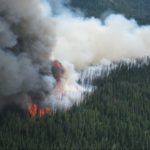Resilient Federal Forests Act: Myth vs. Fact
Posted: November 27, 2017Source: Healthy Forest Healthy Communities

MYTH: H.R. 2936 undermines our nation’s bedrock environmental laws.
- FACT: False. The bill does not waive the National Environmental Policy Act (NEPA), the Endangered Species Act (ESA), or any other environmental law. Rather, it builds upon streamlining provisions already included in NEPA itself via Categorical Exclusions. The bill guarantees compliance with forest plans and other publicly developed environmental documents, provides for robust public engagement and ensures that the work of land managers is not hampered by duplicative bureaucratic processes.
MYTH: H.R. 2936 minimizes public participation in decision-making on National Forests.
- FACT: Wrong. The bill encourages public participation. It incentivizes collaboration by empowering local forest health collaboratives and allowing Resource Advisory Committees to design and implement broadly supported forest health projects. It also requires courts to consider the costs of inaction when hearing a case against a forestry project. Finally, the bill creates a new binding arbitration pilot program to require national litigant groups that oppose forest health projects to come to the table with a reasonable alternative – rather than just saying “no” and stalling these important projects indefinitely in the courts.
MYTH: Fires, insects and disease are natural, therefore forest thinning is futile.
- FACT: False. Catastrophic wildfires and insect infestations differ from other natural disasters (like hurricanes) in one important respect: they can be contained and prevented. We can affect the extent and growing intensity to which catastrophic wildfires devastate landscapes and impact communities. H.R. 2936 prioritizes forest health and fire prevention, not simply fire suppression. Countless studies clearly demonstrate the benefits of tree thinning to forest health and resiliency.
MYTH: The biggest threat to endangered species is logging on public lands.
- FACT: Wrong, and don’t just take our word for it. There’s a reason that mainstream environmental groups, including the Nature Conservancy, are teaming with the Forest Service and private partners (yes, loggers) to thin our nation’s over-grown, fire prone landscapes. It’s because active management, including selective logging and other restoration practices, improve forest resiliency and mitigate environmentally devastating wildfire. H.R. 2936 expands this work on federal lands to protect millions of acres of habitat, hundreds of nest sites, rare plant populations, watersheds, etc., that are being destroyed by catastrophic wildfire.
MYTH: There is no need for litigation reform because the Forest Service spends an inconsequential amount in court.
- FACT: Untrue. The Forest Service’s annual litigation costs could provide funding for the operations of one to two national forests by themselves. Even more importantly, however, litigation has had a chilling effect on all other projects across the nation. The threat of litigation forces land managers to make their planning documents “bullet proof,” wasting valuable time and resources. The result is not better forest management; it is what a former Forest Service chief calls “analysis paralysis.” This paralysis and fear of litigation has led to the reduction in forest health projects, resulting in larger and more severe fires.
MYTH: Forests heal themselves after a wildfire and dead tree removal is unnecessary.
- FACT: This is misleading and incomplete. After many wildfires, brush invades and remains for two hundred years or more. These brush fields are highly susceptible to re-burn that can prevent the new growth of trees. If we want our grandchildren to see trees on national forests, and have clean air to breathe, then we must actively reforest. By law, the removal of dead trees after fires or catastrophic events pays for the reforestation of the area, restoring landscape vitality and leveraging private investment to maximize restoration work. Currently the Forest Service only reforests roughly three percent of burned areas due to limited funds and fear of litigation. This bill provides additional authorities to the Forest Service to ensure the maximum area possible is reforested within five years.
MYTH: The issue is climate change, not forest management.
- FACT: False. The objective of H.R. 2936 is to restore resiliency to our federal forests. Resilient forests better withstand drought, insects, disease, wildfire and – the left is sure to love this one – a changing climate. Our common objective should be to improve the health and resiliency of federal forests for this and future generations. Alarmingly, the Vice President of Public Resources at the California Forestry Association testified that national forests in California, traditionally carbon consumers, are now net emitters in the region – all due to delayed restoration activities. This bill gives the Forest Service and Bureau of Land Management tools to achieve those ends.
MYTH: More funding alone will avert future catastrophic wildfires.
- FACT: Wrong. The Forest Service has testified the status quo is “not near enough of what we need to be doing to change the conditions on the landscape, to restore the resiliency of those forests and reduce the wildland fire threat to our communities.” The challenge before the nation’s land managers is not just fire suppression costs, it is forest health.
